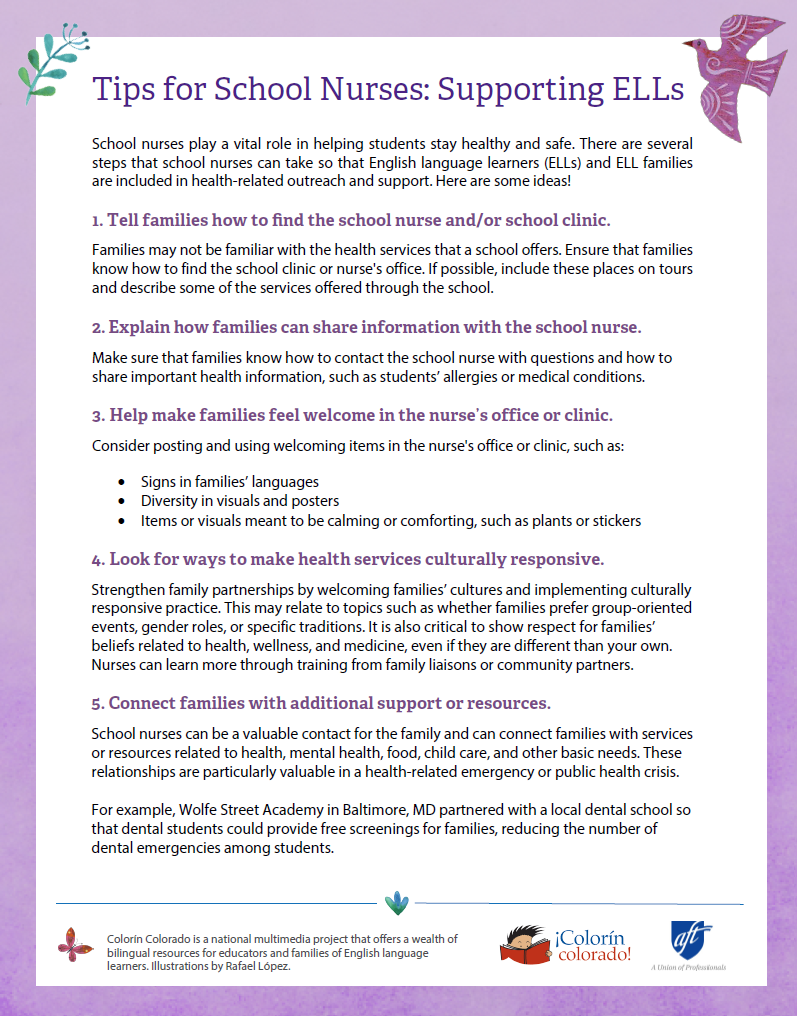School nurses play a vital role in helping students stay healthy and safe. There are several steps that school nurses can take to ensure that English language learners (ELLs) and ELL families are included in health-related outreach and support.
Here are some ideas for getting started, inspired by the following two Colorín Colorado projects:
- What Multilingual Health Services and Support Look Like in Brockton, MA
- Wolfe Street: How a Community School Supports ELLs
You can also print and share this article as a tip sheet, and see all related resources in our School Nurses and ELLs Resource Gallery.
Special thanks to the Health Services Team in Brockton, MA for reviewing this article!
Getting Started
1. Ensure that families know how to find the school nurse and/or school clinic.
Families may not be familiar with the services that a school offers. Ensure that families know how to find the school clinic and the school nurse. If possible, include the nurse's office or school clinic on tours and share some of the services offered through the clinic.
2. Explain how families can share important information with the school nurse.
Make sure that families know how to contact the school nurse with questions and how to share important health information, such as students' allergies or medical conditions.
Video: Breaking down barriers with multilingual families
Astride Jeune in Brockton, MA explains why her role as a bilingual school nurse is so important for family outreach and how the nurses support each other.
Welcoming Families
3. Look for ways to make families feel welcome in the nurse's office or clinic.
School nurses can start this process by getting to know students and looking at their office or the school clinic from the point of view of multilingual families. Some things to look for or add might include:
- Signs in families' languages
- Diversity in visuals and posters
- Items or visuals meant to be calming or comforting, such as plants or stickers
4. Look for ways to make the school's health services culturally responsive.
Strengthen family partnerships by welcoming families' cultures and implementing culturally responsive practice. This may relate to topics such as whether families prefer group-oriented events, gender roles, or specific traditions.
It is also critical to show respect for families' beliefs related to health, wellness, and medicine, even if they are different than your own. Nurses can learn more through training from family liaisons or community partners.
Video: Using Indigenous families' rituals for restorative healing
Dr. Karen Woodson describes a partnership through the National Compadres Network, Cara y Corazón ('Face and Heart' in Spanish), that used Indigenous families' own traditions to promote healing for students.
5. Ensure that families have access to health information in their languages.
Families have a legal right to information from their child’s school in their primary language. Increasing language access will also increase families' levels of trust with the school and their engagement around health issues.
Language access
In order to support communication families' language access, school nurses can take the following steps:
- Find out what language supports are available, such as working with an interpreter, using a language line, translation services for written notes or forms, or translation apps where appropriate.
- Keep in mind that there may be language resources that haven't been shared with health personnel. You can start by asking for more information from your supervisor, ELL specialists, or administrators.
- Request training on how to use these supports if needed.
- If appropriate language supports are not being offered, you may be able to improve the situation through some hands-on advocacy. Start by bringing this matter to the attention of a supervisor or administrator and explaining how communication issues are affecting students, families, and staff. Keep notes on what is working — and what isn't — so you can share it with others.
- You may also be able to make some important connections with community partners, especially health or immigrant organizations that work with your students' families. There may even be medical professionals among your families or in the community who could volunteer as interpreters or part-time assistants in the school clinic.
Translation apps
Translation apps can fill in gaps where needed. Your school may already be using an app like this with families. And if you search for "medical translation apps," you will find a range to choose from, although it's important to find someone who can help you guage how accurate any app you use is related to medical information.
Translation apps are best for quick questions, reminders, and straightforward issues. They are not ideal for complex or sensitive communication — and they are not perfect. They also can't take cultural considerations into account the way that bilingual, bicultural staff members can. While translations apps become more accurate and offer a good starting place, it's important to advocate for long-term, people-centered solutions.
Video: How school nurses collaborate with interpreters in Brockton, MA
Tracy Politano describes how she partners with interpreters to communicate with multilingual families and how she encourages families to advocate for language access in their medical appointments.
6. Educate families about their right to an interpreter in other medical settings.
Families have a right to access language support in medical settings. Ensure families understand these rights and how to request that support.
Connecting Families with Resources
7. Look for ways to connect families with additional support or resources.
School nurses can be a valuable contact for the family, especially for questions about health and medical care. They can also help connect families with services or resources related to health, mental health, food, child care, and other basic needs. These relationships are particularly critical if a health-related emergency or public health crisis emerges that requires regular communication between the school and family, such as the COVID-19 pandemic.
Video: Why I love my work with families as a community facilitator
Marie-Jean Philippe, a community facilitator and liaison for Haitian families in Brockton, talks about her role and her work helping her families navigate health care.
8. Keep in mind the impact of immigration status.
Families' access to health and dental care may be impacted by their immigration status. Look for ways to connect families with free or low-cost medical care in the community if needed.
Video: How immigration status impacts access to dental insurance
Dr. Clemencia Vargas explains why undocumented families have a major gap when it comes to dental care.
Building Partnerships
9. Collaborate with colleagues who partner closely with families
There may be staff members who have close partnerships with families, such as family liaisons, ELL educators, bilingual educators, interpreters, social workers, or counselors. Each of these staff members will have valuable insights and contacts in the community, as well as ideas on how to support communication with families. Look for opportunities to work together and share the work you are doing as well.
Your colleagues' roles
Staff members who will work with ELLs will play different roles and have different skills. For example:
- Family liaisons work very closely with families around a wide range of issues that may include enrollment, academic support, social and emotional support, and services related to basic needs. In some cases, certain staff members may specialize in academic issues, while a social worker or family advocate focuses on basic needs and social services.
- Interpreters are trained and certified to provide spoken translation. In some cases, interpreters may also be certified to provide written translation, although other teams may handle written translations.
- Bilingual educators are trained to provide instruction in two languages, or to work within a bilingual setting. They may be bilingual themselves and are experts on bilingualism.
- ELL educators are experts in language development. They may be multilingual themselves, but it is not required that they speak their students' languages, especially since they may be teaching students who speak many languages. ELL educators often are very familiar wtih the systems that support ELL students and they may be the adults who work most closely with ELLs and ELL families. They also may be addressing basic needs and social services.
- Keep in mind that bilingual staff members are not necessarily trained as interpreters and should not be pulled regularly from other duties to interpret. Learn more about the differences between interpreters and bilingual staff in this related chart.
Note: If you are a bilingual nurse, or work with a bilingual nurse, talk with a supervisor about establishing guidelines for communication with families so that bilingual staff are not being pulled from other duties to interpret or translate for other staff members.
10. Build connections with the community.
Look for ways to build community partnerships, such as with local health clinics, community organizations, or institutions of higher education. For example, Wolfe Street Academy in Baltimore, MD partnered with a local dental school so that dental students could provide free screenings for families, reducing dental emergencies in the community. In addition, tap into family networks for ideas, help with communication, and volunteers. The better you know your community, the more information you’ll have at your fingertips to answer questions.
Video: Opportunities for dental students
Dr. Vargas describes the ways in which her dental students benefit from the experience they get at the dental screenings.
Video Project: Community Schools and ELLs
Visit Wolfe Street Academy in Baltimore, MD, a school with more than 76% ELLs, to see how this community school is supporting its students and families through programs and services that include dental screenings, food giveaways, after-school activities, and much, much more!










Add new comment